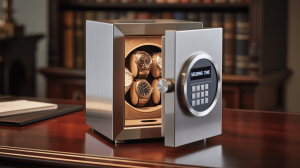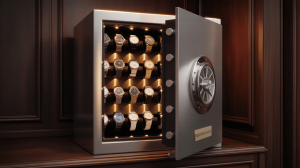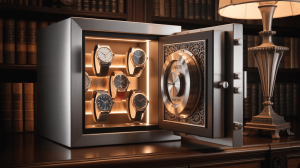2025 Buyer’s Guide: High-Security Watch and Jewelry Safes You Can Trust. But here’s the kicker… Not every safe is created equal—this guide narrows down features, certifications, and styles to find vaults that safeguard your valuables for years to come.
1. Evaluating Burglary Resistance Standards
Start by choosing safes with UL RSC or ETL burglary ratings. These certifications verify forced-entry resistance using drills, pry bars, and torches. Higher minute ratings indicate tougher construction. Here’s the deal… look for multi-bolt steel doors, reinforced hinge protection, and concealed anchor points to halt would-be thieves.
| Certification | Test Method | Resistance Level |
|---|---|---|
| UL RSC | Simulated pry and tool attacks | 5–10 minute forced-entry delay |
| ETL Burglary | Independent lab impact tests | Equivalent anti-pry performance |
2. Fire Protection and Insulation Features
Fire can render watches and jewelry worthless if heat breaches the safe. Seek UL 72 Class 350 or higher—30–120 minutes at up to 1,800 °F. Insulating materials such as gypsum composite boards or ceramic fleece panels maintain internal temps below 350 °F. Ready for the good part? Intumescent door gaskets expand to seal smoke and flames, preserving delicate oils and gemstones.
3. Interior Climate and Moisture Controls
Humidity and dust degrade movements and metal finishes. Choose safes with IP54-rated seals, built-in desiccant chambers, or active dehumidifiers. Digital hygrometers display real-time relative humidity. Here’s the deal… maintaining 40–50% RH prevents leather strap cracking and gemstone fogging.
4. Lock Mechanism Comparison
Mechanical dials, electronic keypads, biometric scanners, and dual-lock systems each offer pros and cons. Mechanical locks never die from power loss; electronic codes allow audit logs; biometrics grant fast access. Dual-lock safes require two authentication methods, maximizing security.
| Lock Type | Power Requirement | Access Speed |
|---|---|---|
| Mechanical Dial | None | Moderate |
| Electronic Keypad | Batteries/adapter | Fast |
| Biometric Scanner | Batteries | Instant |
5. Capacity Planning for Watches and Jewelry
Inventory current pieces—watches on pillows require ~2″ width and 1.5″ height; jewelry trays need slots for rings, earrings, and necklaces. Add 20–30% extra space for expansions. Here’s the deal… modular foam inserts let you reconfigure compartments as your collection grows.
6. Watch Winder Integration Essentials
For automatic watches, integrated winders keep movements running. Look for adjustable turns-per-day (650–2,000), directional modes (CW, CCW, bi-directional), and quiet motors (<25 dB). Pause programs prevent over-winding. Removable winder trays convert bays into static storage when not in use.
7. Aesthetic Finish and Material Options
Safes come in matte powder-coat steel, brushed stainless, wood veneer, or leather wrap. Choose finishes that complement room décor—industrial loft, classic library, or modern gallery. Ready for the good part? high-gloss piano lacquer models add art-gallery flair.
| Finish Type | Visual Style | Upkeep |
|---|---|---|
| Powder-Coat Steel | Matte contemporary | Wipe with damp cloth |
| Wood Veneer | Warm traditional | Polish annually |
| Leather Wrap | Luxury boutique | Condition leather biannually |
8. Interior Lighting and Display Considerations
Integrated LED strips or fiber-optic spotlights illuminate watches without heat damage. Warm white emphasizes gold hues; cool white makes steel and diamonds pop. Motion sensors activate lights upon door opening, conserving power when closed.
9. Noise and Vibration Dampening
Quiet operation matters in bedrooms or offices. Rubber-dampened motor mounts, precision bearings, and soft-close hinges reduce noise below 25 dB. Here’s the deal… test decibel specs and user reviews to avoid humming distractions.
10. Power Supply and Backup Solutions
Dual-power designs use AC adapters and rechargeable batterypacks. Low-battery alerts—LED indicators or app notifications—prevent downtime. USB-C trickle charging and solar options exist. Always keep a hidden manual override key for emergencies.
| Power Option | Backup Method | Maintenance |
|---|---|---|
| AC Adapter | — | Annual visual check |
| Rechargeable Battery | Manual override key | Recharge every 6–12 months |
| USB-C Charging | Hidden override PIN | Inspect cable quarterly |
11. Installation and Anchoring Guidelines
Proper anchoring transforms a safe into a fortress. Bolt to floor joists or wall studs with heavy-duty sleeve or lag anchors. Level the safe before tightening to prevent door binding. Ready for the good part? conceal anchor plates under interior liners or trim for a clean finish.
12. Smart Connectivity for Remote Monitoring
Bluetooth and Wi-Fi safes deliver tamper, door-open, and humidity alerts to your smartphone. Remote lock/unlock, TPD adjustments, and audit log reviews give total oversight—ideal for frequent travelers or shared collections.
| Connectivity Feature | Functionality | Benefit |
|---|---|---|
| Tamper Alerts | Real-time notifications | Immediate security awareness |
| Remote Control | App-based operations | Convenience on the go |
13. Budget and Value Analysis
Entry-level watch safes ($200–$400) cover small collections with basic security. Mid-range ($400–$800) adds fire rating, climate control, and display elements. Premium ($800+) includes biometrics, smart features, winders, and luxury finishes. Here’s the deal… prioritize certifications and core features before optional extras.
14. Warranty, Support, and Longevity
A robust warranty—2–5 years on structure and electronics—reflects manufacturer confidence. Onsite service, spare parts availability, and responsive support are crucial. Read user feedback on claim processes and repair quality to avoid headaches.
15. Final Selection Checklist
Compile criteria—capacity, burglary/fire ratings, lock type, climate controls, winders, finish, lighting, noise level, power options, anchoring, smart features, warranty, and budget—into a scorecard. Compare top models side by side to choose the vault that aligns with your security needs and style preferences.
Conclusion
Choosing a high-security watch and jewelry safe in 2025 means balancing certifications, functionality, and décor. Ready for the good part? Use this guide to find a trusted vault that protects and showcases your valuables for years to come.
FAQ
Q1: What fire rating should I choose?
Aim for UL 72 Class 350—30 minutes at 1,200 °F or more.
Q2: Do smart watches require special humidity levels?
Maintain 40–50% RH using desiccants or active dehumidifiers.
Q3: Are biometric locks secure?
Yes—premium scanners use encrypted templates and backup override options.
Q4: How often replace desiccant packs?
Replace every 6–12 months depending on local climate.
Q5: Can I retrofit an existing safe with winders?
Some manufacturers offer aftermarket winder inserts—verify compatibility before purchase.







